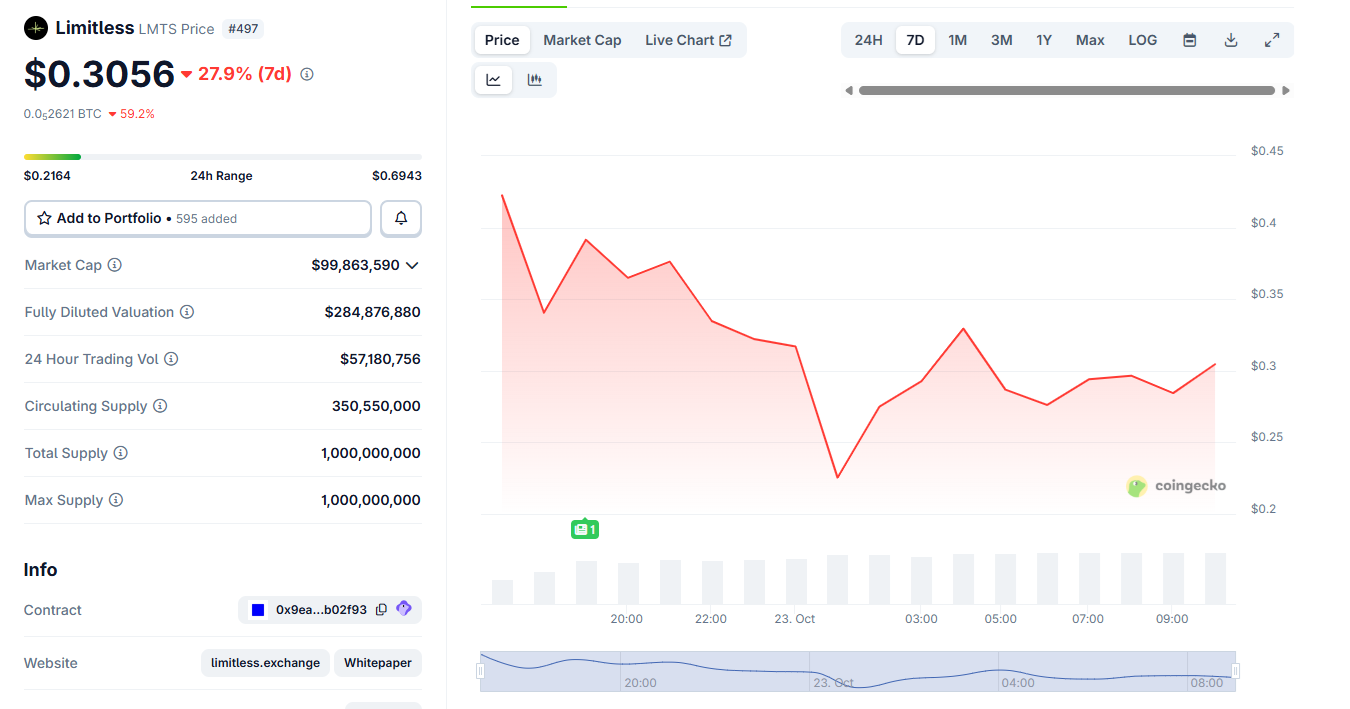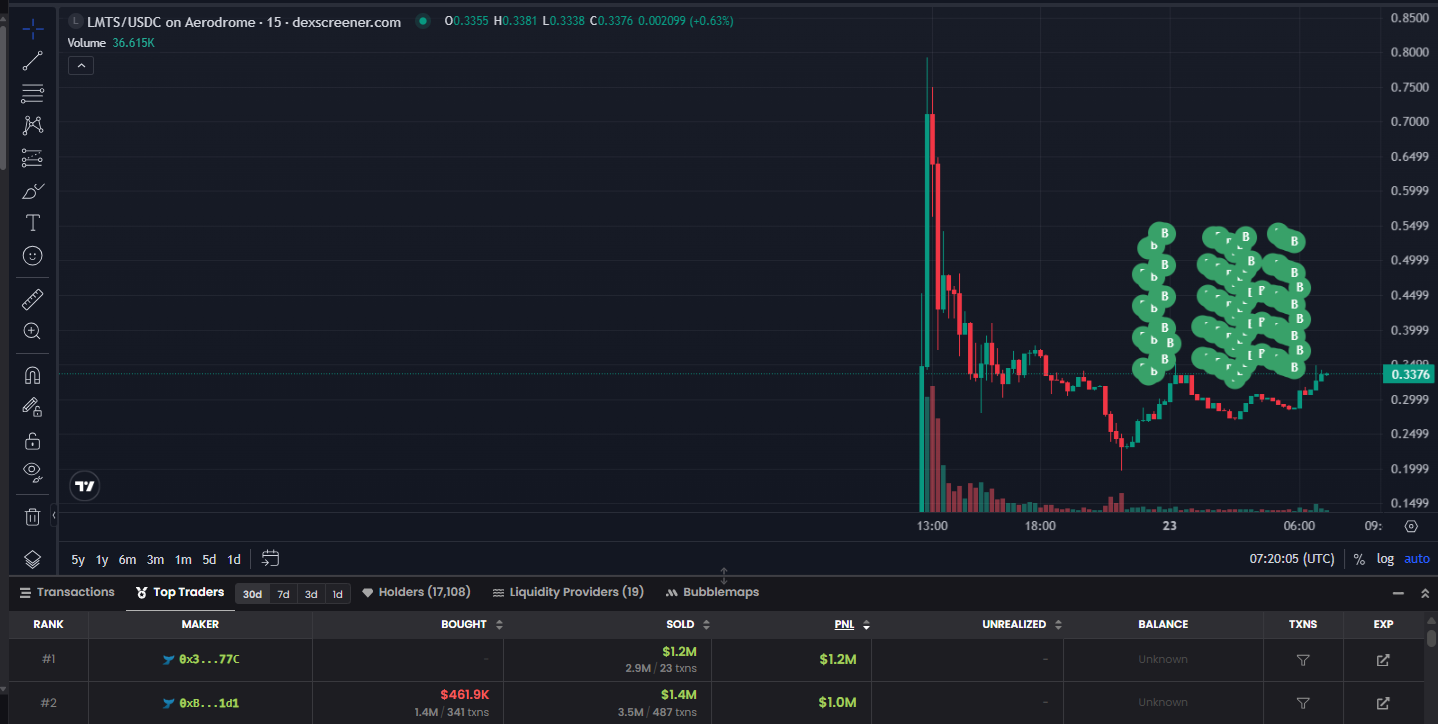The Limitless token LMTS crashed over 58% shortly after its launch due to team wallet sales aimed at price stabilization through concentrated liquidity on Base blockchain platforms like Aerodrome and Uniswap, leading to high volatility in the prediction market project.
-
LMTS token plunged from $0.35 to $0.20 within hours of launch on October 22, 2025.
-
On-chain data revealed team wallets depositing and trading tokens immediately, triggering the sharp decline.
-
The project raised $10 million in funding prior to token generation event, yet liquidity remains thin with $5.7 million in LMTS and $4.2 million in stablecoins.
Discover why the Limitless token LMTS crashed 58% post-launch amid team sales for stabilization. Explore prediction market trends, volatility risks, and recovery potential in this in-depth analysis.
What Caused the Limitless Token LMTS Crash After Launch?
The Limitless token LMTS experienced a dramatic 58% crash shortly after its October 22, 2025 launch, primarily due to sales from team-associated wallets implementing a concentrated liquidity strategy on the Base blockchain. This approach, intended to stabilize prices, instead led to an immediate value drop as tokens were deposited and traded on decentralized exchanges like Aerodrome Slipstream and Uniswap. Despite a partial recovery to around $0.30, the incident highlighted the risks of thin liquidity in emerging prediction markets.
How Did Team Wallet Activity Contribute to LMTS Price Volatility?
The Limitless project’s team wallets began depositing LMTS tokens right after the token generation event (TGE), sparking the initial sell-off that drove prices from $0.35 to a low of $0.20. On-chain analytics from platforms like Dex Screener showed one key wallet, designated for liquidity provision, selling portions of its holdings while simultaneously engaging in buy-back activities, netting $1 million in gains but only repurchasing $461,000 worth of tokens. This strategy, described by the team as an on-chain market-making effort, aimed to maintain price within a specific range but resulted in heightened volatility due to the pool’s imbalance—$5.7 million in LMTS liquidity versus $4.2 million in stablecoins. Experts in decentralized finance note that such concentrated liquidity models, popularized on Aerodrome, can amplify swings in low-volume assets like LMTS, which lacks centralized exchange listings and relies on decentralized trading pairs for price discovery.
 LMTS lost over 58% of its value in the first day of trading, later making a small recovery. The token still relies on Aerodrome and Uniswap for its liquidity, leading to volatile prices. | Source: CoinGecko.
LMTS lost over 58% of its value in the first day of trading, later making a small recovery. The token still relies on Aerodrome and Uniswap for its liquidity, leading to volatile prices. | Source: CoinGecko.Limitless, a prediction market platform built on Base, had recently secured $10 million in funding to expand into micro-betting and short-term event resolutions, positioning itself amid a booming sector. The airdrop distribution targeted retail users and influencers, which fueled anticipation but also increased selling pressure post-launch. Data indicates multiple small accounts received allocations, contributing to the retail-driven dumps alongside team actions.
The project’s founder, in a statement on X (formerly Twitter), emphasized that all team tokens are locked for 12 months with a subsequent 24-month linear vesting schedule. Addressing the controversy, the post clarified: “I remind you that team tokens are locked for 12 months followed by a 24 month linear vest. 0xBF3132977d9801506deF8E927c4Ff06E5b0801d1 is the liquidity wallet which is running onchain MM strategy.” This wallet’s activities drew scrutiny, including a public exchange with Evgeny Gaevoy, founder of Wintermute, who questioned the market-making claims. Limitless denied intentional profit-taking, asserting the sales were part of liquidity management, though the token’s thin trading volume—totaling just $1.4 million in transactions—exacerbated the impact.
I remind you that team tokens are locked for 12 months followed by a 24 month linear vest. 0xBF3132977d9801506deF8E927c4Ff06E5b0801d1 is the liquidity wallet which is running onchain MM strategy
— CJ / 晨杰 (@cjhtech) October 22, 2025
Despite the feud, on-chain evidence shows the liquidity wallet resuming buys, though broader whale and retail sales continue to pressure LMTS. The platform’s focus on simple, fast-resolution prediction markets aligns with industry trends, where platforms like those on Base are gaining traction for their low fees and speed. According to blockchain analytics from CoinGecko, LMTS’s market cap dipped below expectations, underscoring the challenges for new entrants in a competitive field.
 Limitless presented its so-called market maker wallet, which was among the biggest sellers of LMTS. Later, the wallet partially re-bought at a lower range. | Source: Dex Screener.
Limitless presented its so-called market maker wallet, which was among the biggest sellers of LMTS. Later, the wallet partially re-bought at a lower range. | Source: Dex Screener.As of late October 2025, LMTS trades around $0.30, with ongoing price discovery hampered by its decentralized-only presence. The concentrated liquidity setup on Aerodrome binds trading to specific ranges, leaving the token vulnerable outside those bounds. Financial experts from firms like Wintermute highlight that while such mechanisms can enhance efficiency, they demand robust initial liquidity to avoid crashes like this one.
Frequently Asked Questions
What Is the Limitless Token LMTS and Why Did It Launch on Base?
The Limitless token LMTS powers a prediction market platform on the Base blockchain, enabling users to bet on short-term events with quick resolutions. Launched on October 22, 2025, via Aerodrome and Uniswap, it benefited from Base’s scalability and low costs, attracting $10 million in pre-launch funding. However, immediate team sales led to a 58% crash, raising concerns about early volatility in this proxy for prediction market growth.
Is the Limitless Team Selling LMTS Tokens Intentionally?
No, the Limitless team states that sales from designated wallets are part of an on-chain market-making strategy for price stabilization, not profit-locking. All core team allocations remain locked for 12 months with gradual vesting, though one liquidity wallet did sell initially before buying back portions. This approach, while aimed at concentrated liquidity, contributed to the post-launch drop amid thin trading volumes.
Key Takeaways
- Launch Volatility in Prediction Markets: LMTS’s 58% crash illustrates the risks of new tokens on decentralized exchanges, especially with concentrated liquidity models that can amplify price swings.
- Team Strategies Under Scrutiny: Limitless’s market-making wallet netted gains but resumed buying, highlighting the need for transparent on-chain practices in emerging projects.
- Future Growth Potential: With $10 million funding and Base’s advantages, Limitless could rebound if liquidity improves—investors should monitor vesting schedules and whale activity for entry points.
Conclusion
The Limitless token LMTS crash of over 58% post-launch underscores the volatile nature of prediction market tokens on platforms like Base, driven by team wallet sales for concentrated liquidity management. While the project denies deliberate dumping and points to locked allocations, the incident has sparked debates on transparency in decentralized finance. As LMTS stabilizes around $0.30 with ongoing buy-backs, the sector’s growth trajectory suggests opportunities ahead—stay informed on on-chain developments to navigate these high-risk assets effectively.
